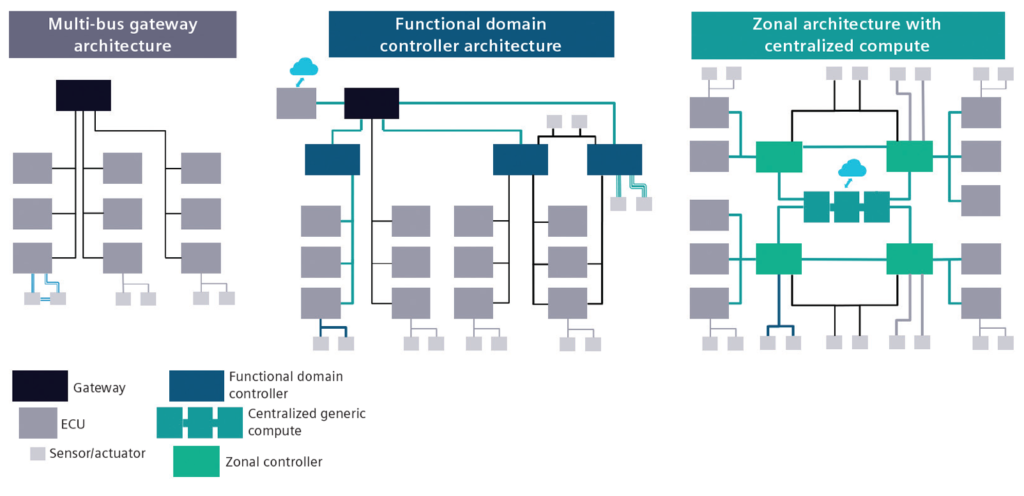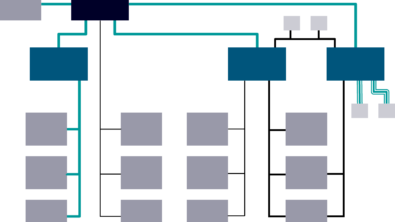What makes E/E systems for heavy equipment and off-highway vehicles unique?

Complexity is expanding in E/E systems for heavy equipment and off-highway vehicles due to the very same reasons it is for so many other consumer goods. With the introduction of new features, functions and systems for autonomy, electrification, connectivity, data services, and safety, these innovations are a cause for more and more reliance on electrical and electronics.
In recent years, E/E architectures experienced rapid growth in the number of electronic control units (ECUs) in the average architecture. In response, heavy equipment manufacturers have begun consolidating ECUs in high-performance computation nodes to support new and more advanced features and functionalities.
Architecture evolution – vehicle configuration management
OEMs must add more ECUs to the typical vehicle architecture to support the greater functionality demanded in modern vehicles. This growth has gotten to the point where space availability in the
architecture has become limited. In the past, architectures were distributed with ECUs having a single
role and networks being used to carry point-to-point signals over a controller area network (CAN) or local
interconnect network (LIN). With space growing limited, a trend has developed to consolidate ECUs into high-performance computation nodes. Today, OEMs are investing a significant amount of money in the development of zonal architectures, which are more centralized (figure 1).

Verification of all electrical interconnect in the virtual world before building a physical prototype is the key. It enables designers to minimize errors and hold down design costs while meeting quality targets.
Siemens provides tools to help companies extend their ability to comfortably manage electrical system complexities and how it will feed through to the product. From systems, networks and software architecture to targeted aftermarket maintenance of the electrical distribution system (EDS), Siemens has developed a tool suite that provides a flexible solution.
Our webinar Effective design and engineering of E/E systems for heavy equipment and off-highway vehicles covers the Capital™ software solution, which is part of the Xcelerator portfolio, the comprehensive and integrated portfolio of software and services from Siemens.
Powerful security
Recent growth in vehicle complexity and connectivity have also heightened the need to implement a powerful security strategy. Off-highway vehicles are becoming less isolated devices and more connected to electrical power grids, the internet and wireless networks. This connectivity introduces new potential openings for attacks and requires manufacturers to add gateways for separating in- and off-
vehicle networks and to add firewalls.
SAE, a professional association which develops internationally recognized standards, has defined a standard for the interoperability of on-board communication networks, J1939, supporting heavy-duty and off-highway vehicles. The adoption of this standard enables tractors, trailers and accessories to connect together without customization. Read our white paper Implement SAE J1939 in Commercial Vehicle EDS Design which discusses how Siemens’ Capital software suite of tools can be used to generatively design the E/E systems of the vehicle from the E/E architecture definition, revolutionizing the vehicle E/E design process. This process can utilize the standard library of signals and messages from the SAE J1939 standard, the defined functions, and E/E architecture to generate the E/E design.
The expanding complexity in the heavy equipment industry is placing a significant amount of pressure on the manufacturers of heavy-duty vehicles from agricultural tractors to construction equipment and more. To keep up with the demands of the industry, electrical engineers are balancing numerous requirements before safely delivering designs to production. As these designs are increasingly driven by E/E systems and embedded software, they require a solution to accommodate for the high degree of complexity and sophistication of modern electrical systems, software and networks in modern vehicles. Siemens’ Capital tool suite embraces the challenge to help electrical engineers meet tomorrow’s design challenges.


